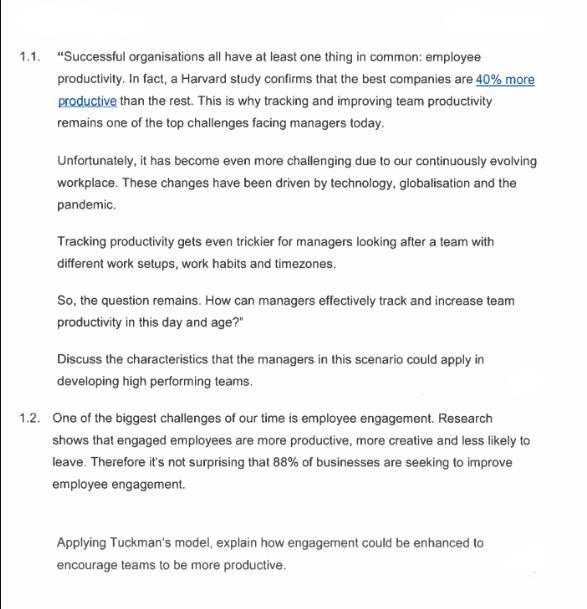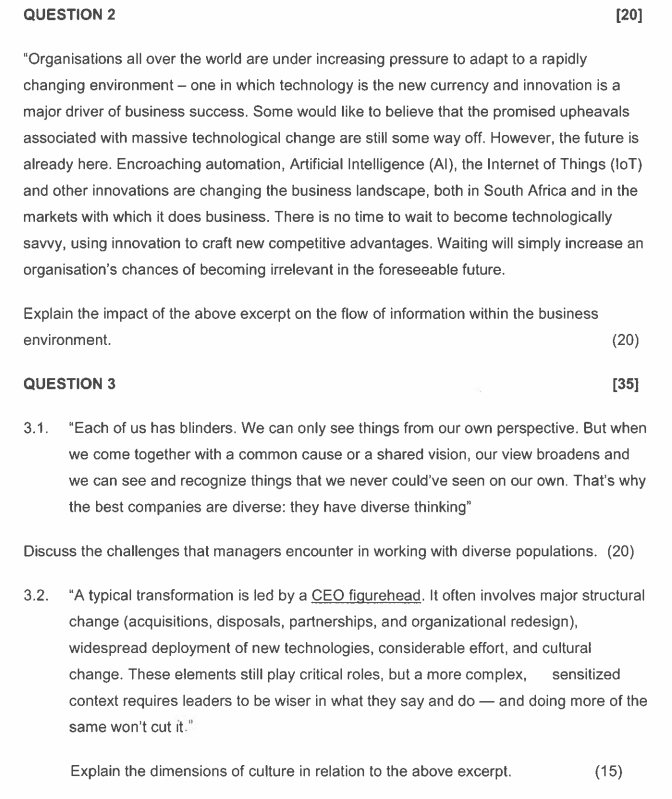Answered step by step
Verified Expert Solution
Question
1 Approved Answer
1.1. Successful organisations all have at least one thing in common: employee productivity. In fact, a Harvard study confirms that the best companies are



1.1. "Successful organisations all have at least one thing in common: employee productivity. In fact, a Harvard study confirms that the best companies are 40% more productive than the rest. This is why tracking and improving team productivity remains one of the top challenges facing managers today. Unfortunately, it has become even more challenging due to our continuously evolving workplace. These changes have been driven by technology, globalisation and the pandemic. Tracking productivity gets even trickier for managers looking after a team with different work setups, work habits and timezones. So, the question remains. How can managers effectively track and increase team productivity in this day and age?" Discuss the characteristics that the managers in this scenario could apply in developing high performing teams. 1.2. One of the biggest challenges of our time is employee engagement. Research shows that engaged employees are more productive, more creative and less likely to leave. Therefore it's not surprising that 88% of businesses are seeking to improve employee engagement. Applying Tuckman's model, explain how engagement could be enhanced to encourage teams to be more productive. QUESTION 2 [20] "Organisations all over the world are under increasing pressure to adapt to a rapidly changing environment - one in which technology is the new currency and innovation is a major driver of business success. Some would like to believe that the promised upheavals associated with massive technological change are still some way off. However, the future is already here. Encroaching automation, Artificial Intelligence (AI), the Internet of Things (IoT) and other innovations are changing the business landscape, both in South Africa and in the markets with which it does business. There is no time to wait to become technologically savvy, using innovation to craft new competitive advantages. Waiting will simply increase an organisation's chances of becoming irrelevant in the foreseeable future. Explain the impact of the above excerpt on the flow of information within the business environment. (20) QUESTION 3 [35] 3.1. "Each of us has blinders. We can only see things from our own perspective. But when we come together with a common cause or a shared vision, our view broadens and we can see and recognize things that we never could've seen on our own. That's why the best companies are diverse: they have diverse thinking" Discuss the challenges that managers encounter in working with diverse populations. (20) 3.2. "A typical transformation is led by a CEO figurehead. It often involves major structural change (acquisitions, disposals, partnerships, and organizational redesign), widespread deployment of new technologies, considerable effort, and cultural sensitized change. These elements still play critical roles, but a more complex, context requires leaders to be wiser in what they say and do and doing more of the same won't cut it." Explain the dimensions of culture in relation to the above excerpt. (15) QUESTION 4 Discuss the process of developing effective negotiation skills. [15]
Step by Step Solution
There are 3 Steps involved in it
Step: 1

Get Instant Access to Expert-Tailored Solutions
See step-by-step solutions with expert insights and AI powered tools for academic success
Step: 2

Step: 3

Ace Your Homework with AI
Get the answers you need in no time with our AI-driven, step-by-step assistance
Get Started


